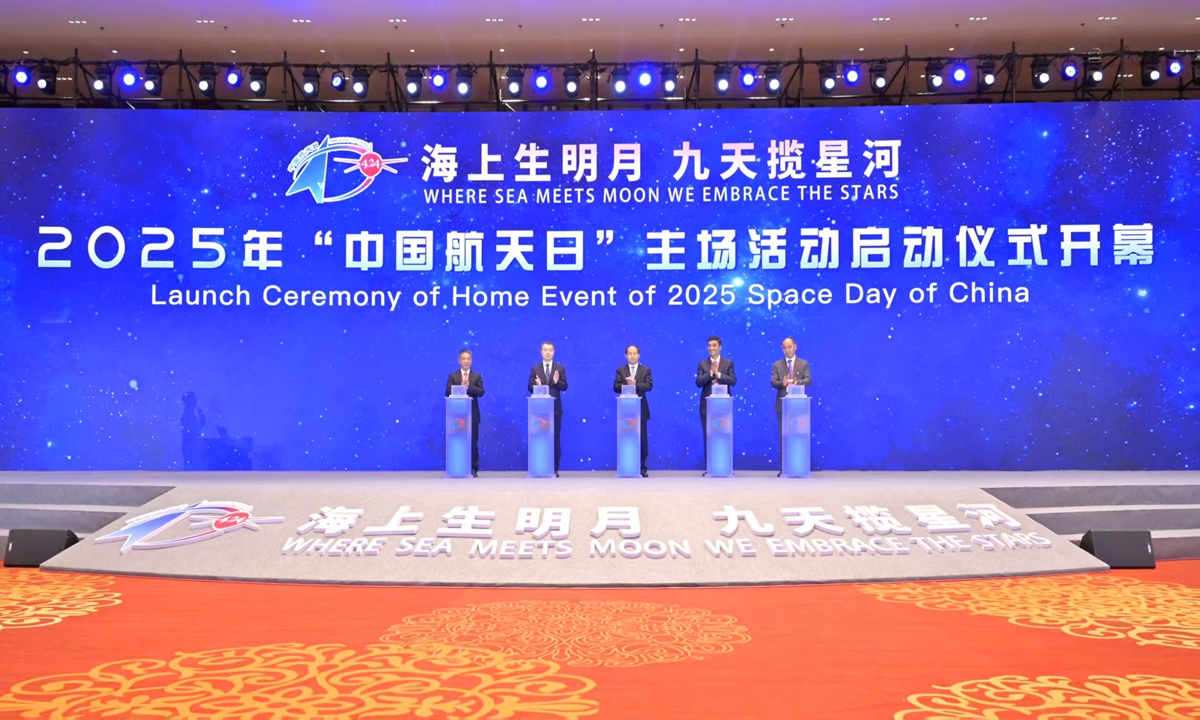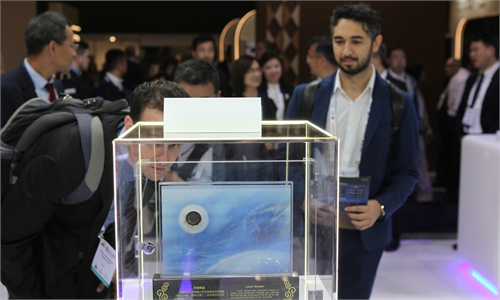CNSA releases intl co-op projects for deep-space exploration amid celebration of Space Day of China

Launch ceremony of home event of 2025 Space Day of China. Photo: Courtesy of CNSA
To mark the 10th Space Day of China, an annual event inaugurated in 2016 to highlight the country's space achievement and promote international cooperation, Shanghai staged Thursday a grand launch ceremony for this year's national celebration, during which the China National Space Administration (CNSA) unveiled series of major deep-space exploration initiatives, once again demonstrating China's commitment to open and collaborative engagement with the global space community.
The CNSA announced Thursday the international cooperation projects for the Chang'e-8 mission which is part of the country's Phase-4 lunar exploration program. A total of 10 projects from 11 countries and regions as well as one international organization were selected.
The selected cooperation programs include the Pakistani Lunar Rover, jointly proposed by the Space & Upper Atmosphere Research Commission of Pakistan (SUPARCO) and the International Society for Terrain-Vehicle Systems, and Lunar Neutron Analyzer developed by Thailand's Ministry of Higher Education, Science, Research and Innovation and the National Astronomical Research Institute of Thailand.
Projects from countries and regions such as Turkey, Italy, Egypt and Iran were also selected for the Chang'e-8 international payload cooperation.

Launch ceremony of home event of 2025 Space Day of China. Photo: Courtesy of CNSA
"That is said very commonly that China-Pakistan friendship is higher than the Himalayas and deeper than the seas. Now we are reaching to the moon, beyond the limits of the Earth," Amjad Ali, deputy director general of SUPARCO, Pakistan's national space agency, told the Global Times on Thursday on the sideline of the national space day launch event."We have already participated in China's Chang'e-6 mission with a satellite ICUBE-Q orbiting the moon and now we have also signed MoU with the CNSA for the upcoming Chang'e-8 mission with a 30-kilogram rover," Ali said.
"We are very excited with the prospective cooperation between China and Thailand. Because this program has started quite recently, less than three years ago. And now we are on the trajectory to send our payload to land on moon with the Chang'e-8 mission in 2029," Wiphu Rujopakarn, deputy director of the National Astronomical Research Institute of Thailand, told the Global Times on Thursday.
"So I think Thai people would be very excited, because now when we look toward the moon, we are going to know that there will be a little piece of equipment that is made by our people. Being physically present on the moon and that is only made possible because of that cooperation with the CNSA," Rujopakarn applauded.
Friendship is the highest result from such cooperation, but also we hope to learn from decades of experience that China has in space exploration. There is so much to learn. We need to have more people into these projects in order to learn more and make more friends, he said.
Marking the 50th anniversary of the establishment of China-Thailand diplomatic relations, the CNSA has invited Thailand to be this year's guest country of honor. The two countries plan to deepen cooperation on payloads for the Chang'e-7 and Chang'e-8 missions, remote sensing data applications, and joint satellite development, according to the CNSA.
Shan Zhongde, the CNSA head, told the Global Times on Thursday that CNSA will work closely with international partners to advance cooperation on the Chang'e-8 mission with the goal of achieving new scientific discoveries and technological breakthroughs in lunar exploration and to jointly contribute to the well-being of humanity.
According to the CNSA, China plans to launch the Chang'e-8 mission by around 2029. It will land near the Leibnitz-β Plateau in the lunar south pole region and will operate in tandem with the earlier Chang'e-7 mission to conduct scientific exploration and in-situ resource utilization experiments. These efforts aim to lay the groundwork for the construction of an International Lunar Research Station.
Also, on Thursday, the CNSA announced the results of international applications to borrow lunar samples collected during the country's Chang'e-5 mission. Applications from seven institutions across six countries were approved.
The approved institutions include the Institut de Physique du Globe de Paris in France, University of Cologne in Germany, Osaka University in Japan, the SUPARCO, The Open University in the UK, Brown University, and State University of New York at Stony Brook in the US. These institutions will now be able to conduct scientific research using lunar samples returned by the Chang'e-5 mission.
China will also invite international collaboration on its Tianwen-3 Mars probe mission, allocating a total of 20 kilograms of payload capacity for selected international projects.
Space-based Multi-band Variable Object Monitor (SVOM), a joint space science satellite co-developed by China and France, also released its first batch of scientific findings on Thursday.
SVOM, launched by China's Long March-2C rocket on June 22, 2024, has completed in-orbit testing work for the satellite platform and scientific instruments in its some 10 months of flight. To date, per the Chinese developers, SVOM has detected more than 100 gamma-ray bursts (GRBs,) including several of special types and has set a new record for the most distant observation of a short-duration GRB.
The SVOM was officially delivered to the National Astronomical Observatories of the Chinese Academy of Sciences for operational use on Wednesday in Shanghai, under the witness of CNSA and the CAS.
During the handover event, delegates from both China and France hailed that SVOM not only represents the most powerful satellite system to date for multi-band comprehensive observations of gamma-ray bursts, but also marks a major milestone for the China-France satellite project, marking a unique model of high-level, in-depth international space cooperation between two major space powers.




